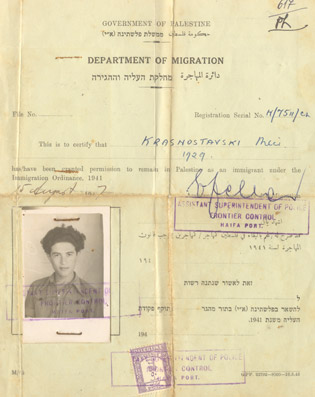Meir’s Story
In 1945, Meir made his way back to Korets, where he found an elderly relative, who took him in to live in her house. Two young women, Lizka and Chaika, were also living with her. Meir and Chaika soon became a couple, and towards the end of the year, they decided to move to Lodz.
In Lodz, Meir and Chaika met other young survivors who were preparing to make aliya with the Dror youth movement. These young people, like many Holocaust survivors, were convinced that a Jewish state was necessary in what they considered their ancient Jewish homeland in order to protect the Jewish people. However, the State of Israel was not established until 1948. In 1945, immediately after the war, the British still governed the area, then known as the Mandate for Palestine , and strictly limited immigration. As a result, many Jews took part in secret immigration, called Ha’apala . Meir and Chaika prepared to become “illegal” immigrants along with the other young survivors.
In 1946, they traveled to Germany and then to France to receive false papers and to board a ship. Like other similar ships, the “Latrun” was captured by the British and all the people on board were sent to an internment camp on Cyprus in order to discourage further attempts at “illegal” immigration. Meir, Chaika, and the other detainees found themselves living in tents behind barbed wire. Every month a specific number of Jews was released and allowed to immigrate. Meir and Chaika were detained in the camps for six months.

TESTIMONY: “CYPRUS”
“We gathered together to sing the songs of the Land of Israel .”
—Meir Kransnostawski
Finally, after their release from detainment, Meir and Chaika moved to a kibbutz called kibbutz Ginossar in the Galilee. A year later, they left kibbutz Ginossar to help found the Ghetto Fighters’ kibbutz . That same year, Meir and Chaika were married.
On the kibbutz , Meir worked in the fields. Even though he came from a family of bakers, Meir came to consider himself first and foremost a farmer. He studied agriculture in college and was in charge of the agricultural activities of the kibbutz for many years. With all his experience and education, Meir became a consultant to Israel ’s Ministry of Agriculture.
Meir also served in the Israel Defense Forces (IDF ). He was a first lieutenant and then a major, and eventually the Region Commander in the Western Galilee.
Meir is proud that he was able to help build and serve his country.


TESTIMONY: “TELLING THE STORY”
“ I didn’t know how to cry.”
—Meir Kransnostawski
